The journey of biometric attendance and access control systems is a testament to the incredible strides made in security technology. From ancient methods to modern marvels, this evolution has been driven by the need for more secure, efficient, and convenient ways to manage access and track attendance.
Ancient Beginnings to 19th Century Innovations
The earliest forms of biometric identification can be traced back to ancient civilizations, where fingerprints and handprints were used for identification purposes1. However, it wasn’t until the late 19th century that a scientific approach to fingerprint identification was developed, marking the first step towards modern biometric systems
20th Century: The Rise of Biometric Modalities
The 20th century saw the advent of various biometric modalities, including face recognition, iris scanning, and finger scanning. These technologies laid the foundation for the accurate and reliable biometric systems we use today. The second half of the century, in particular, witnessed a significant increase in accuracy and security with the introduction of biometric time and attendance systems.
- Finger based attendance system
- Card based attendance system
- Face based attendance system
- Pin based attendance system
- Iris based attendance system
- Vein based attendance system
- Adhaar based attendance system
- Visitor management system
The Digital Age: Biometrics in the 21st Century
With the turn of the millennium, biometric technology became ubiquitous, securing smartphones, streamlining airport experiences, and even revolutionizing healthcare1. The present landscape boasts fingerprint readers, facial recognition, and iris scanners as commonplace tools for authentication

The Present and Future: AI and IoT Integration
Today, advancements in machine learning and artificial intelligence have further enhanced the accuracy and efficiency of biometric systems1. The integration of biometrics with the Internet of Things (IoT) and blockchain technology is opening new frontiers in secure identity management and decentralized authentication1. Touchless biometrics, driven by the need for hygienic solutions, are becoming increasingly prevalent.
Conclusion: A Secure and Convenient Future
As we look ahead, the evolution of biometric attendance and access control systems is poised to continue. With continuous advancements in sensor technology and algorithms, these systems will become even more sophisticated, playing a pivotal role in addressing global challenges from cybersecurity to frictionless travel and healthcare services





